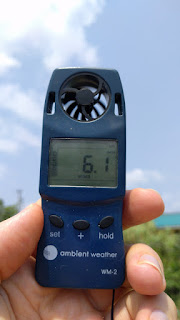Today was the windiest day I remember on the land since we bought it and began construction well over a year ago now. I tried measuring the wind and found gusts of up to 6 meters per second:
Mostly for my own records, here is a rough estimate of the distribution of wind speeds over time:
The highest wind speed I observed was 6.2 meters per second. I would guess that 90% of the time, the wind speed was about 5 meters per second or less. I would also estimate that the average and median wind speeds were between 3 and 4 meters per second. Between gusts, the wind speed usually dropped down to 0.5-2 meters per second. These measurements were taken between 11.00 and 13.30.
The reason wind speed is of particular interest to me is with regards to the floating house. It is currently my goal to make the floating house “disconnected” and mobile. In other words, it will have solar panels to power everything on board, including the motors that will drive the propellers to maneuver the house around the pond, and it can move around the pond.
I’ve considered how to handle many of the various issues this requires:
- electricity : solar panels
- cooking : electric ovens may take too much electricity from the solar panels so we’ll probably use propane for this
- fresh water : we have found commercial fresh water filters designed to take water from a nearby pond and process it for household use. You don’t get any more “nearby” than this pond.
- sewage : grey water can be filtered and returned to the pond, and I’m considering whether black water can be easily carried ashore and composted
- getting on board : it is our intention to build a moderately large and flat floored raft-like autonomous ferry boat that can easily shuttle people, equipment and supplies to and from the floating house many times per day.
F = 0.5 * p * u^2 * c * A
Where F is the drag force, p is the density of air, u is the speed of the air moving relative to the house, c is the coefficient of drag, and A is the cross-section area of the house profile.
From this Wikipedia page, I get a value for the density of air (p) at 1atm and 30degs Celsius of 1,164 kg/m^3.
If I target the ability to hold position at up to 6 meters per second, then u = 6 m/s.
For now, I will use a coefficient of drag (c) of 1.
And based on the 8m x 3.5m profile size, we get A = 28 m^2.
So F = 0.5 * 1.164 kg/m^3 * 36 m^2/s^2 * 1 * 28 m^2 = 587 kg*m/s^2 = 587 N
So I need to make sure that the combined force of all thrusters on the house can produce about 600 N.
For comparison, the BlueRobotics T200 thruster produces 50N of force at 350W of power. I would like to believe that my 300mm diameter propellers and high efficiency PMG 132 motor can achieve higher thrust per watt than the 4x smaller 76 mm propeller on the T200.
But using the same force per watt, I would need to be prepared to power the thruster with 4.2kW of electricity to resist a 6 m/s wind gust. This isn’t too bad given that my current plan is to have about 24kWh of batteries on board.
Bear in mind that because of the u^2 in the above equation, a 3.5m/s wind would produce 4x less force (and presumably use about 4x less electrical power to resist), so these batteries could likely power the house for a whole day like today without any sunshine. And it was actually sunny enough today that 8-12 solar panels on the roof could have supplied enough electricity to keep those batteries full throughout the day.
And if the batteries are running low, that should leave plenty of time to run a winch cable to anchor points around the pond to passively hold the house in place until the strong winds pass. (This is also my strategy for powerful storms and other even more occasional even higher wind situations.)
In conclusion, the kind of “back of the envelope” calculation done above suggests that the house may be able to operate on a day like today without being blown against its control up against the edge of the pond.
